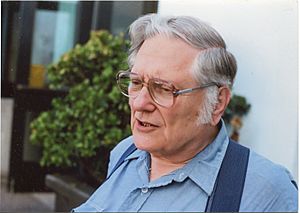William Kahan facts for kids
Quick facts for kids
William Morton Kahan
|
|
|---|---|

Kahan in 2008
|
|
| Born | June 5, 1933 Toronto, Ontario, Canada
|
| Education | University of Toronto (BS, MS, PhD) |
| Known for |
|
| Awards |
|
| Scientific career | |
| Fields | |
| Institutions | University of California, Berkeley |
| Thesis | Gauss–Seidel Methods of Solving Large Systems of Linear Equations (1958) |
| Doctoral advisor | Byron Griffith |
| Doctoral students | James Demmel |
William "Velvel" Morton Kahan (born June 5, 1933) is a smart Canadian mathematician and computer scientist. He is a professor emeritus at the University of California, Berkeley. He won the important Turing Award in 1989. This award was for his big help in making computers do math very accurately.
Contents
Early Life and Education
William Kahan was born in Canada on June 5, 1933. He went to the University of Toronto. There, he studied mathematics. He earned three degrees from this university. He got his bachelor's degree in 1954. Then, he received his master's degree in 1956. Finally, he earned his Ph.D. in 1958.
Today, Kahan is a retired professor. He taught mathematics and computer science. He worked at the University of California, Berkeley.
Making Computers Better at Math
William Kahan is famous for his work with "floating-point" numbers. These are numbers with decimal points, like 3.14 or 0.005. Computers use these numbers for many calculations. Kahan helped create the IEEE 754 standard. This is a set of rules for how computers should handle these numbers. It makes sure computers do math correctly and consistently.
Because of his important work, people call him "The Father of Floating Point." He was key in making the first IEEE 754 rules. He also helped update the standard later on. This made computer math even more reliable.
Special Tools for Accuracy
In the 1980s, Kahan created a program called "paranoia." This program tests computers. It looks for problems in how they do math with floating-point numbers. It helps find and fix errors.
He also developed the Kahan summation algorithm. This is a clever way to add many numbers together. It helps reduce small errors that can happen when computers add numbers. This makes the final answer much more accurate.
Kahan also came up with the term "Table-maker's dilemma." This describes a problem. It's about how hard it can be to make sure math tables are perfectly rounded. Sometimes, it's very difficult to know the exact right way to round a number.
Helping Hewlett-Packard
William Kahan also worked with Hewlett-Packard (HP). HP made early pocket scientific calculators. The first HP-35 calculator had some small math accuracy issues. Kahan helped HP improve their math programs. This made their calculators much more precise.
He also helped design the math programs for other HP calculators. These were the HP Voyager series. He even wrote parts of their instruction manuals.
Awards and Recognition
William Kahan has received many honors. In 1994, he became an ACM Fellow. This is a special title for computer professionals. In 2005, he was inducted into the National Academy of Engineering. These awards show how important his work has been in computer science.
See also
 In Spanish: William Kahan para niños
In Spanish: William Kahan para niños
- Intel 8087

